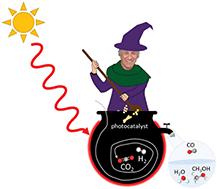当前位置:
X-MOL 学术
›
Chem. Soc. Rev.
›
论文详情
Our official English website, www.x-mol.net, welcomes your
feedback! (Note: you will need to create a separate account there.)
Shining light on CO2: from materials discovery to photocatalyst, photoreactor and process engineering.
Chemical Society Reviews ( IF 40.4 ) Pub Date : 2020-07-28 , DOI: 10.1039/d0cs00597e Yuchan Dong 1 , Paul Duchesne 1 , Abhinav Mohan 2 , Kulbir Kaur Ghuman 3 , Paul Kant 4 , Lourdes Hurtado 1 , Ulrich Ulmer 1 , Joel Y Y Loh 5 , Athanasios A Tountas 1 , Lu Wang 1, 6 , Feysal M Ali 1 , Meikun Xia 1 , Roland Dittmeyer 4 , Geoffrey A Ozin 1
Chemical Society Reviews ( IF 40.4 ) Pub Date : 2020-07-28 , DOI: 10.1039/d0cs00597e Yuchan Dong 1 , Paul Duchesne 1 , Abhinav Mohan 2 , Kulbir Kaur Ghuman 3 , Paul Kant 4 , Lourdes Hurtado 1 , Ulrich Ulmer 1 , Joel Y Y Loh 5 , Athanasios A Tountas 1 , Lu Wang 1, 6 , Feysal M Ali 1 , Meikun Xia 1 , Roland Dittmeyer 4 , Geoffrey A Ozin 1
Affiliation

|
Heterogeneous catalysis, a process in which the reaction of gaseous or liquid chemical reagents is facilitated at the surface of a solid material, is responsible for the majority of industrial-scale chemical and fuel production reactions. The energy required to drive these reactions has historically been derived from the combustion of non-renewable fossil fuels and carries an unavoidably large carbon footprint. More recently, the development of environmentally responsible and sustainable chemical industries is increasingly motivated by greenhouse gas-induced climate change, thus creating demand for eco-friendly heterogeneous catalytic processes. This includes innovative approaches enabled by renewable forms of energy, such as the electrification of chemical and petrochemical processes, utilization of CO2 as a feedstock and the incorporation of light into catalytic reactions. Herein we review the conversion of solar energy to chemical energy using CO2, and describe how the photophysical and photochemical properties of nanostructured metal oxide photocatalysts have been engineered to efficiently incorporate light into heterogeneous gas–solid CO2 hydrogenation reactions. Realizing high photonic and energy efficiencies in these systems has demanded innovation in not only photocatalyst engineering, but also photoreactor and process engineering. Rather than exclusively providing an in-depth discussion of the chemistry and science within each individual study, this Tutorial Review highlights the multidisciplinary character of photocatalysis studies by covering the four essential components of a typical research work in this field (materials engineering, theoretical modelling, reactor engineering and process development) via case studies of the archetypal indium oxide catalyst materials. Through advances in these four components, progress has been made towards the ultimate goal of industrializing the production of CO2-derived chemicals and fuels.
中文翻译:

照亮二氧化碳:从材料发现到光催化剂、光反应器和工艺工程。
多相催化是一种在固体材料表面促进气态或液态化学试剂反应的过程,是大多数工业规模化学和燃料生产反应的原因。驱动这些反应所需的能量历来来自不可再生化石燃料的燃烧,并且不可避免地产生大量碳足迹。最近,温室气体引起的气候变化越来越推动对环境负责和可持续化学工业的发展,从而产生了对生态友好的多相催化过程的需求。这包括通过可再生能源形式实现的创新方法,例如化学和石化过程的电气化、CO 2的利用作为原料并将光纳入催化反应。在此,我们回顾了利用CO 2将太阳能转化为化学能,并描述了如何设计纳米结构金属氧化物光催化剂的光物理和光化学性质,以有效地将光纳入非均相气固CO 2 中。加氢反应。在这些系统中实现高光子效率和能源效率不仅需要光催化剂工程的创新,还需要光反应器和工艺工程的创新。本教程回顾并没有专门对每项研究中的化学和科学进行深入讨论,而是通过涵盖该领域典型研究工作的四个基本组成部分(材料工程、理论建模、反应器工程和工艺开发)通过典型氧化铟催化剂材料的案例研究。通过这四个部分的进步,已经朝着工业化生产CO 2的最终目标取得了进展。-衍生化学品和燃料。
更新日期:2020-08-17
中文翻译:

照亮二氧化碳:从材料发现到光催化剂、光反应器和工艺工程。
多相催化是一种在固体材料表面促进气态或液态化学试剂反应的过程,是大多数工业规模化学和燃料生产反应的原因。驱动这些反应所需的能量历来来自不可再生化石燃料的燃烧,并且不可避免地产生大量碳足迹。最近,温室气体引起的气候变化越来越推动对环境负责和可持续化学工业的发展,从而产生了对生态友好的多相催化过程的需求。这包括通过可再生能源形式实现的创新方法,例如化学和石化过程的电气化、CO 2的利用作为原料并将光纳入催化反应。在此,我们回顾了利用CO 2将太阳能转化为化学能,并描述了如何设计纳米结构金属氧化物光催化剂的光物理和光化学性质,以有效地将光纳入非均相气固CO 2 中。加氢反应。在这些系统中实现高光子效率和能源效率不仅需要光催化剂工程的创新,还需要光反应器和工艺工程的创新。本教程回顾并没有专门对每项研究中的化学和科学进行深入讨论,而是通过涵盖该领域典型研究工作的四个基本组成部分(材料工程、理论建模、反应器工程和工艺开发)通过典型氧化铟催化剂材料的案例研究。通过这四个部分的进步,已经朝着工业化生产CO 2的最终目标取得了进展。-衍生化学品和燃料。











































 京公网安备 11010802027423号
京公网安备 11010802027423号